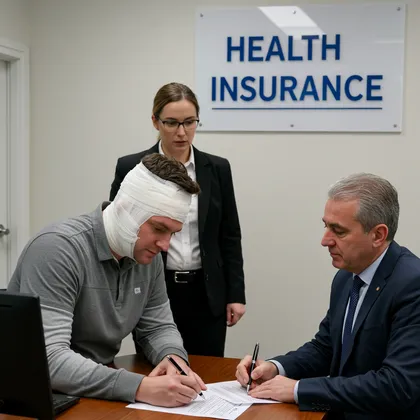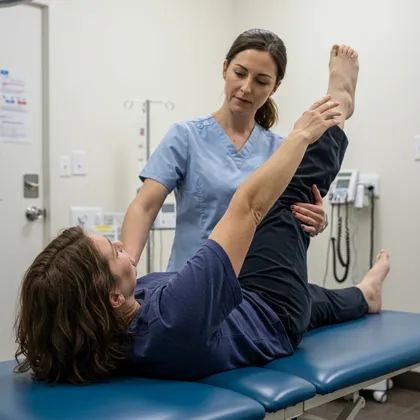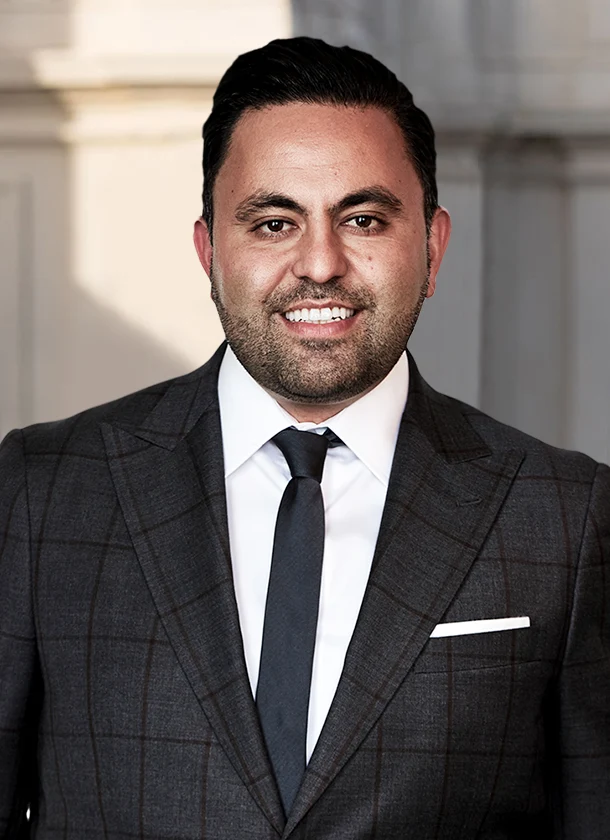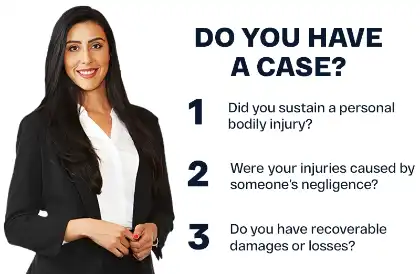TL;DR: Yes, physical therapy can increase your personal injury settlement. Therapy records provide documented proof of pain, recovery effort, and medical necessity, which support higher compensation for medical costs, pain, and future care. To protect your rights, stay consistent with treatment and consult a personal injury lawyer at the AK Law Firm at (888) 488-1391 for a free case review.
Table of Contents
Physical therapy can make a big difference in how much compensation you may receive after an accident. Every session creates medical records that show your injury is real, that you are following treatment, and that recovery takes time. These records help insurance companies and courts see the full impact of your injury.
Your therapy notes also show if your pain lasts longer than expected, if you struggle with daily activities, or if you may need care in the future. Because insurance companies often question whether treatment is necessary, consistent therapy and strong records can strengthen your claim and raise the value of your settlement.
If you’re recovering from an accident, attending therapy helps both your health and your case. Injury attorneys can organize your records, explain your future medical needs, and present your claim clearly to the insurance company.
Here are the main ways physical therapy can affect your settlement:
- Physical therapy records prove injury and recovery efforts.
- Consistent treatment supports a higher settlement value.
- Notes justify future medical costs and care needs.
- Pain and movement limits increase compensation for suffering.
- AK Law’s personal injury lawyer can use therapy records to build your case.
How Physical Therapy Boosts Settlement Value
Physical therapy can play an important role in increasing the value of your settlement. It helps you recover from your injuries and provides clear proof of how serious your condition is. Insurance companies rely on evidence, and physical therapy records can make it harder for them to downplay your injuries or reduce your compensation.
Here are the main ways physical therapy can raise the value of your settlement:
Documented Proof Of Injury And Recovery
Each visit creates written proof of your injury, how bad it is, and how you’re getting better over time. These physical therapy records in personal injury cases can make your claim stronger, especially when the insurance company or a court reviews them.
Here’s how physical therapy shows proof of your injury and recovery:
- Physical Therapy Records — Notes and progress reports from your therapist show how long recovery takes and what type of care is needed.
- Objective Evidence Over Subjective Pain — Therapists document how much movement you have, your strength levels, and specific actions that cause pain or weakness.
- Severity & Functional Limitations — These records also show whether you’re still in pain, unable to move normally, or unable to work or handle daily activities.
Increased Medical Expenses
The more sessions you need, the more your medical costs may rise, which can increase your total claim value. Your injury lawyer can consider these expenses when calculating your damages.
According to Thervo’s website, physical therapy costs can vary, depending on whether you have insurance or not.
- With Insurance — PT ranges from $20 to $60 per session.
- Without Insurance — Each session can cost between $80 and $150.
Over a six- to eight-week period, the total cost with insurance can range from $160 to $1,450. Note that these private physical therapy costs don’t include diagnostic tests.
Several things can affect the price of physical therapy:
- The type of therapy (aquatic, manual therapy, etc.)
- The length of the session (longer or intensive sessions are typically more expensive).
- The therapist’s experience and credentials (those with certifications may charge more).
- The location of the service (rural or urban areas, in the clinic, or at home).
The number of sessions you need reflects the true cost of your injury and treatment.
Justifying Future Medical Expenses
Not all injuries heal quickly. Some require long-term treatment, and physical therapy records can help show the need for ongoing care. These records can support your claim by offering clear medical evidence of what recovery lies ahead.
Here’s how physical therapy helps justify future medical costs:
- Shows that you’re still in pain or having difficulty with movement.
- Documents the need for more sessions or follow-up treatment.
- Provides written support from your physical therapist about ongoing care.
- Gives experts, like doctors or life care planners, the information to explain your future needs.
- Helps estimate how long recovery might take and whether additional treatments, like surgery, could be required.
That is why documentation from therapy sessions matters. It gives a fuller picture of your long-term medical needs and supports your claim for future expenses. Your personal injury attorney can compile these records when pursuing your case.
Boosting Pain And Suffering Compensation
Physical therapy assists in boosting your pain and suffering settlement by providing consistent records of pain, setbacks, and mobility issues that support claims for emotional and physical distress. PT notes can show:
- When your pain gets worse.
- If you’ve had setbacks in your recovery.
- The ways your injury limits your movement or daily activities.
If your therapy includes treatments for long-term pain, it may show that your injury is permanent, long-lasting, or that you may need ongoing care. These records paint a clearer picture of how your injury affects you physically and emotionally. Attorneys who handle personal injury cases often collaborate with medical professionals and economic experts to assess potential non-economic damages and provide a more precise estimate of damages.
Enhancing The Credibility Of Your Claim
Insurance companies may question how serious your injury is. Physical therapy records can back up your claim because they come from trained professionals who track your recovery.
They can strengthen your case by:
- Showing detailed reports from a licensed therapist.
- Documenting how your injury affects your daily life.
- Providing clear proof of injury for claim payout, such as pain, weakness, or limited movement.
A well-documented case makes it harder for the insurance company to deny or reduce your claim. Consistent therapy and detailed records strengthen your position during settlement negotiations or in court.
Proving Effort To Recover (Mitigation Of Damages)
The law expects you to try to recover after an accident. Going to physical therapy shows you’re doing your part. Missing appointments or stopping treatment too soon can harm your case. Insurance companies may claim that you worsened your injury or failed to follow medical advice. Consistent therapy builds a record of effort, making your claim stronger and more credible.
Factors That Influence A Settlement
When you’re working through a personal injury claim, several factors influence your settlement value. Many people wonder how much money you can sue for a motorcycle accident, but the answer depends on the specific circumstances of the case. Physical therapy plays a major role in documenting your recovery, limitations, and ongoing needs. Here are the main factors that affect the value of your settlement:
- Severity and Permanence of Injuries — The more serious and lasting your injury, the higher the potential settlement. Physical therapy records show if recovery is slow or if the injury causes permanent impairment, which can increase your compensation.
- Medical Expenses (Past & Future) — All medical bills, including physical therapy, are recoverable damages. Ongoing physical therapy costs can make up a large portion of your future medical expenses.
- Lost Wages & Reduced Earning Capacity — Physical therapy may interfere with your ability to work or return to work. Therapists can document physical limitations that affect your job duties, supporting claims for lost wages or reduced earning capacity.
- Pain & Suffering — Treatment logs, pain scores, and recovery frustrations can support claims for pain and suffering. These records show the emotional and physical toll your injury has taken.
Each of these factors, backed by physical therapy records, can increase your settlement value by showing the full impact of your injury.
The following types of accidents often cause these types of injuries:
- Motor vehicle accidents resulting from:
- Slip-and-fall accidents
- Workplace accidents
- Sports-related incidents
- Lifting accidents
These incidents can result in pain, limited movement, or long-term conditions that require extensive therapy to treat. Reports like the true cost of San Francisco bicycle accidents highlight how recovery expenses quickly add up in serious cases.
What You Should Know About Legal And Insurance Rules
Even if you’re doing everything right, going to physical therapy, following your doctor’s advice, and keeping records, insurance companies don’t always make things easy. There are rules about what treatments they’ll pay for, and they may try to lower your settlement in different ways.
Here are a few important things you should know when dealing with insurance and legal matters in a personal injury case:
“Reasonable And Necessary” Treatment Under Insurance Policies
Most California auto insurance policies cover physical therapy only if it is deemed medically reasonable and necessary. Insurers like State Farm and Allstate have specific guidelines for what counts as essential treatment.
To get your physical therapy covered, insurance companies typically look for:
- Referral from a Licensed Provider — You’ll need a doctor’s referral to start physical therapy. It shows that the treatment is necessary for your recovery.
- Treatment That Matches the Injury — The number of sessions and how often you go should match the severity of your injury. Insurance companies won’t approve excessive therapies that aren’t needed.
- Consistency With Recovery Timelines — Your physical therapy should follow a timeline that matches your injury and recovery goals. Progress over time can show that the treatment works and remains necessary.
Understanding what insurers look for can help you stay on track and avoid issues with your claims.
Use Of Independent Medical Exams (IMEs)
According to the National Library of Medicine, an IME is a medical assessment performed by a doctor who doesn’t treat the patient. Insurers, employers, or lawyers often request one when there’s uncertainty about the cause of an injury, the extent of the disability, or the person’s recovery potential.
If you’re still wondering whether you really need to attend the examination, the answer is yes. In most cases, you must go. Skipping it without a valid reason can lead the insurance company to delay or stop your benefits, and you could lose part of your settlement.
The IME doctor might say that you no longer need physical therapy. If the insurer agrees with that opinion, they may stop covering your treatment or lower their settlement offer. That’s why it’s important to have strong records from your doctor and physical therapist.
Surveillance And Claim Denial Risks
Sometimes, insurance companies hire someone to follow you or record your daily activities on video. They use the footage to check if your behavior matches what you reported in your claim.
If you say you can’t move well, but the insurance company has a video of you lifting heavy bags or doing active tasks, they may try to say you’re not really injured.
Even if your pain is real, insurers may use a single moment caught on camera against you, especially if your physical therapy records show ongoing issues.
These practices are part of effective California personal injury settlement strategies that focus on maximizing compensation through thorough medical documentation and consistent care. In more severe cases, a catastrophic injury lawyer in California may be needed to pursue long-term treatment costs.
How Medical Experts And Documentation Strengthen Your Claim
In personal injury cases, expert opinions and accurate records can help explain the severity of your injury and the care you need. These tools show how the injury affects your daily life and help justify your need for current or future treatment.
Here’s how they contribute to your claim:
- Expert Testimony — Medical professionals such as doctors, physical therapists, or life care planners may explain the nature of your injury, the treatment you’ve received, and whether you may need continued care.
- Treatment Notes — Track your pain, symptoms, and how your body responds to therapy over time.
- Functional Capacity Evaluations (FCEs) — Measure what physical tasks you can or cannot do, such as standing, lifting, or walking.
- Progress Reports & Discharge Summaries — Outline your overall recovery and document any lasting effects.
These records and expert insights give insurers and courts a clearer picture of your condition, helping support your claim with objective evidence. Lawyers for personal injury cases can assist victims in gathering available pieces of evidence.
How To Maximize Your Settlement While Recovering
If you’re already attending physical therapy after an injury, you’re taking the right steps for both your recovery and your claim. There are also simple actions you can take to make your treatment support your settlement. These steps show your commitment to healing and give your legal team important documentation to work with, which can contribute to a settlement increase from documented treatment.
- Stick to Your Therapy Schedule — Don’t miss sessions. Follow the plan your doctor or therapist gives you.
- Save All Your Records — Keep receipts, appointment notes, and messages from your provider.
- Request a Written Report — Ask your therapist to write a short report on your pain, limits, or progress.
- Talk to Your Lawyer About Experts — If your injury is serious or long-term, expert testimony may strengthen your claim.
- Stay off Social Media — Avoid posting anything during your recovery. Insurers may use your posts to question your injury.
Common Questions About Physical Therapy And Personal Injury Settlements
It’s normal to have questions about how physical therapy affects your settlement, especially if you’re recovering from an injury and currently in treatment. Below are answers to some of the most common concerns people have during this process. If you still have questions or need legal support, contact Arash Law for free accident lawyer advice.
Does Physical Therapy Increase Settlement?
Yes, physical therapy can increase your settlement. It shows that your injuries are real and need ongoing care. Every session creates records that show how serious your injury is, how long it lasts, and what kind of treatment you need. These records include progress notes, pain levels, and limits in movement. They give insurance companies proof that your injury affects your daily life and recovery. The cost of therapy also adds to your medical expenses, which can raise the value of your claim.
What your physical therapist writes matters more than how many sessions you attend. If the records show slow recovery, lasting pain, or limited movement, your case may receive more compensation for pain, suffering, and future care. A personal injury attorney can use these records to show how the injury changed your life, work, and well-being. The stronger your documentation, the stronger your claim.
Here’s a quick breakdown of how physical therapy affects insurance claims:
| Without PT Records | With PT Records |
| Harder to prove pain | Documented pain/treatment |
| Lower credibility | Verified medical proof |
| Harder to justify future care | Supports long-term treatment needs |
| Reduced payout | Higher compensation |
I’m Getting Physical Therapy After A Car Accident, Will Going To More Sessions Increase My Settlement?
More physical therapy sessions can affect your settlement, but it’s not just about the number of visits. What really matters is what your therapist documents about your injury and progress.
For example, if another driver hits the front of your car and you are diagnosed with whiplash, your neck or back injury may require physical therapy. Even if your insurance covers 16 sessions, the value of your claim depends more on the medical records than the session count. Experienced car crash attorneys can use these records to explain how the injury affects your work, routine, and overall well-being.
Your physical therapy notes can show:
- The severity of your condition and how it affects your daily life.
- Whether you’re making progress.
- Painful or difficult movements and activities.
More sessions may increase your medical expenses, which can raise the total value of your claim. Still, the quality and content of your records have a bigger impact than the number of appointments.
Keep attending your sessions and talk to your provider about any symptoms. Car accident lawyers can use your therapy records to explain how the injury affects your work, routine, and overall well-being.
How Do I Know If I’ll Need Rehabilitation For A Longer Period?
You may need longer rehab if your recovery isn’t going as expected. Some signs show that your body may need more time or care to heal.
You may need to look out for:
- Pain That Won’t Go Away — You still feel pain after your expected recovery time.
- Limited Movement or Strength — You struggle to move or stay strong even after therapy sessions.
- Ongoing Stress or Anxiety — You feel more emotionally or mentally drained as time goes on.
Your physical therapist plays a big role in tracking your progress. According to the American Physical Therapy Association (APTA), therapists may use functional capacity evaluations to assess your condition. If recovery is going well, they may prepare you for discharge. If not, they may extend treatment, recommend new methods, or shift you to the next phase of care.
The best way to know if you’ll need longer rehabilitation is to stay in close contact with your provider. Let them know about any lingering pain or new symptoms. They’ll guide you through your options and help you avoid long-term complications.
Can I Still Start Rehabilitation Even If I’m In A Lot Of Pain?
Yes. Many people begin rehab while still in pain. Your therapist will create a plan that works with your pain level. The goal is to help you heal safely and slowly.
Starting therapy early can:
- Keep your joints and muscles from getting stiff.
- Maintain your body strength while you recover.
- Lower the risk of long-term pain.
Even small steps can make a big difference. Rehab is not about pushing through pain; it’s about moving forward the right way. Always tell your therapist how you feel so they can adjust your treatment.
Who’s Responsible For Paying If I Need Physical Therapy Long-Term?
If you need long-term physical therapy after an accident, the at-fault party’s insurance is typically responsible for covering the costs. However, insurance companies don’t always approve extended care right away. That’s why many injured victims turn to auto accident lawyers to communicate with insurers and protect their rights. They might question whether your treatment is still necessary or argue that your condition should have improved by now.
If you find yourself wondering, “Do I need a personal injury lawyer?” this is often the right time to reach out. Your medical records must clearly show why you still need therapy. A personal injury lawyer can review your medical documents, communicate with the insurance company, and explain the continued need for treatment. By showing the impact of your injuries and the need for future care, your accident attorney can assess whether you’re eligible for additional compensation.
What Can A Lawyer Do To Strengthen Your Personal Injury Claim?
A personal injury lawyer can organize and present your treatment records in a way that supports your eligibility for compensation. Their role involves filing paperwork and connecting your recovery process to the legal requirements of your claim.
To further support your case, they will:
- Gather expert testimony from medical professionals who can explain your injury, your treatment plan, and whether ongoing care may be necessary.
- Organize treatment notes that track your pain levels, symptoms, and how your body responds to therapy over time.
- Use Functional Capacity Evaluations (FCEs) to show what physical activities you can and cannot do after the accident.
- Review progress reports and discharge summaries to show your recovery timeline and any lasting physical limits that affect your daily life.
Many injury attorneys provide legal support regardless of your financial situation, immigration status, race, nationality, age, or language ability. This way, more people can understand their rights, access proper legal guidance, and focus on recovery without added stress.
What’s The Deadline For Filing A Personal Injury Claim In California?
In California, you generally have two years from the date of your injury to file a personal injury lawsuit. This legal deadline is also known as the statute of limitations.
If your claim involves a government agency or someone working for one, the rules are different. You must first file an administrative claim within six months of the injury. If the agency doesn’t respond within 45 days, you’ll have two years from the date of injury to file a lawsuit. However, if the agency denies your claim, you have only six months from the date of denial to take legal action.
Some exceptions may extend the deadline:
- Delayed Discovery of the Injury — If you didn’t know right away that you were injured, the clock may start when you first discover (or reasonably should have discovered) the injury.
- Injured Minors — For children, the two-year deadline usually doesn’t begin until they turn 18. A parent or guardian can also file a claim on the child’s behalf before then.
It’s always safer to act quickly. Waiting too long can make it harder to collect evidence, find witnesses, or recover compensation. If you’re not sure about your deadline, a personal injury lawyer can review your case and help you stay on track.
Don’t Let Your Physical Therapy Go Unnoticed — Talk To A Skilled Attorney
Every physical therapy session creates a record that can support your personal injury claim. These notes show how the injury affects your daily life, how long your recovery takes, and whether you may need future treatment. Insurance companies may overlook or not fully appreciate this information unless it is presented clearly.
Our qualified personal injury lawyers can review your physical therapy records, organize your medical documents, and speak with the insurance company on your behalf. Call us at (888) 488-1391; we’re available 24/7, including weekends and holidays. You can also fill out our “Do I Have A Case?” form to get started.
Our firm serves injury clients across California, providing the legal support you need, no matter where you live in the state.

































